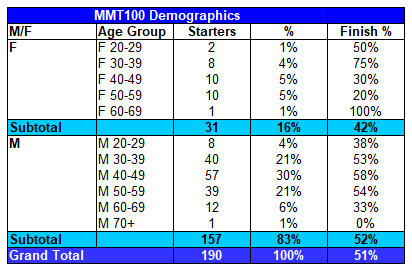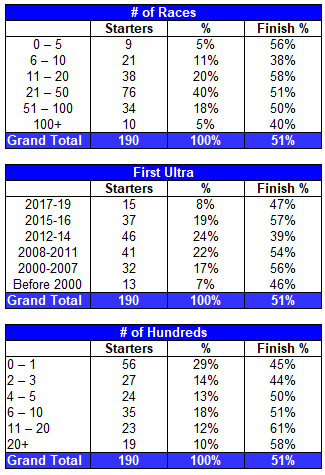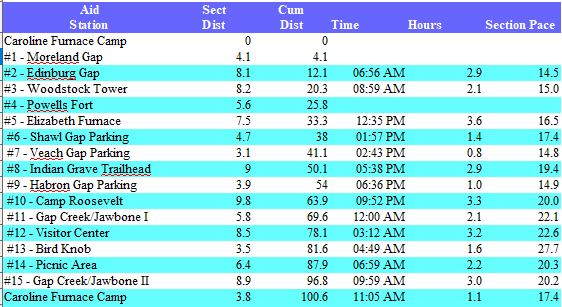Anyone who has spent any time with me knows that I’m a numbers guy. Over the years, I’ve spent so much time calculating and tabulating that it’s difficult for me to completely understand a thing unless there are numbers attached to it. Adjectives only go so far in my opinion. And so every run has to be measured (distance, time, pace, HR, temperature) and logged. The below charts are some of the data I collected about the race. Hopefully, this will be of interest to those of you like me. And if you prefer words to numbers, here’s 3800+ for you to read.
I’ve updated these charts from my preview to include finishing rates among the starters.


Looking at the finishing rates based on experience, there doesn’t appear to be much difference based on number of races or how long runners have been doing ultras. It’s not until you get to 100 mile experience that you see a clear positive correlation. The inexperienced (under 4 finishes) were 5% below average, while the experience (over 10 finishes) were 10% above average.
I think the key takeaway though isn’t that the more experienced had a higher finishing rate. It’s that finishing a lot of 100s only ended up improving your chances of finishing by 30-35% over a complete newbie. These veterans still had a 2 in 5 chance of dropping at some point along the course. Part of that is testament to the difficulty of the hot conditions this year, but more than that is the fact that running 100 miles (over mountains) is hard. I mean like really hard. There are so many variables that can and will go wrong that it’s difficult to prepare and manage through no matter how many times you’ve been handed a buckle. And at the end of the day, we don’t keep coming back because it’s easy.
Splits
Here are my splits between the aid stations. My goal was to hit lap on my watch as I entered, however I failed more often than not. I would find myself exiting an aid station and then remember to note the time. While I’ve adjusted these numbers a little bit, they’re good enough for an event that includes multiple sunrises.

Looking back at my splits, I’m pretty satisfied with my pacing. I was locked in at a 15 minute pace through the first three aid stations to mile 20. I then slowed down 1-2 minutes per mile into early afternoon as it started to heat up and then a couple minutes more to a 19 minute pace (aid #8) during the hottest part of the day. I was able to rally back to (barely) 15 minute pace on the 2 road sections during the day, which means I was moving 2-4 minutes per mile slower on the trail sections than the road. Yikes.
During the night sections, I slowed another 1-3 minutes per mile. I started spending 5-10 minutes at each aid station during this period so that can easily account for about 1 minute of this. The temperatures never really felt like they dropped much overnight so my body didn’t have a chance to cool down, which would have given me a much needed boost. The spike in pace heading to Bird Knob is explained by it being an entire uphill section. Once the sun came up, so did my speed by 2 minutes per mile or all the way up to a slow walk. And then the blazing fast sub-18 minute pace down Crisman Hollow into the finish.
All of this led to buckle #11, which is the best number of all.
